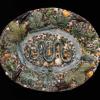'Palissy Ware' Dish
External links
Commentary
'Palissy-ware' dish
Source: Ashmolean Museum, Accession No. 1685 B no. 584-7
Permissions. This image should not be reproduced or distributed in any form (including email, website, social media, printed publications etc.) without the express permission of the Ashmolean Museum. If any reproduction permissions are required, please contact the Ashmolean Picture Library via picture.library@ashmus.ox.ac.uk.
Dimensions. Length (overall) 198 mm; Width (overall) 112 mm
Description. Deep blue oval dish of "Palissy ware", with naturalistically moulded figures of a man clad in a brown loincloth, and a woman in a blue loincloth. Their bodies are turned slightly towards each other, with her left hand resting on his left hip. There are blue and green garlands on their heads, with green and yellow foliage behind, and green herbage behind their crossed legs. Seven green and yellow medallions form an everted rim to half the dish; the remainder is plain. Mottled polychrome back, with two depressions at the backs of the heads.
Commentary. Bernard Palissy, who was born near Agen c. 1510, having worked as an artist in stained glass, turned to pottery about 1540. By 1542 he was established at Saintes. In 1555 the High Constable of France, de Montmorency, commissioned a rustic grotto which was set up by Palissy, at the instance of Catherine de Medici, in the garden of the Tuileries in 1566. Technically his pottery is not dissimilar from that of Saintonge and Poitou, though the technique of casting lizards and other creatures from the life may have been a contribution of his own. Having suffered as a Protestant, and been imprisoned for heresy, Palissy died c. 1590. His moulds were used after his death and his work was continuously imitated. His influence can be found at Avon, near Fontainebleau, in the wares made at the pottery of Barthélemy de Blénod. It is probable that the pieces in the Ashmolean collection date from the first half of the seventeenth rather than from the sixteenth century.
Museum Id. No:
1656 p. 53: Variety of China dishes
1685 B no. 584-7: Disci 4 Chinitici oblongi; in una parte faeminas nudas prostratas habent sua pudenda manibus tegentes
Credits: Abridged from I. H. Lowe in Arthur MacGregor (ed.),Tradescant's Rarities: Essays on the Foundation of the Ashmolean Museum (Oxford, 1983), pp. 275-6.

